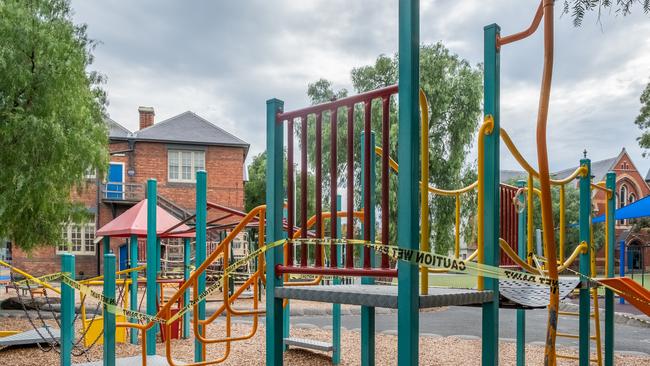Medical experts’ tips: How to keep schools safe from COVID-19
Staggering lunch breaks, regularly cleaning playground equipment, avoiding queues and mixing of year groups are among the social distance measures schools have been told to consider where possible. READ THE EXPERTS’ LIST
NSW Coronavirus News
Don't miss out on the headlines from NSW Coronavirus News. Followed categories will be added to My News.
- Hear from the expert: is it safe to send kids to school?
- Teachers confused by contradictory COVID-19 messaging
- Numbers are our best guide — its time to return to schools
Staggering lunch breaks, regularly cleaning playground equipment, avoiding queues and mixing of year groups are among the social distance measures schools have been told to consider where possible.
Each state and territory will now make its own ruling on how schools will operate during the coronavirus pandemic and can consider a range of recommendations from Australia’s peak medical body.

The Australian Health Principal Protection Committee has published its social distancing recommendations in an effort to assist schools minimise the risk of spreading coronavirus, particularly to parents and teachers.
Parents have been told to make sure their child does not go to school if sick.
“You must keep them at home and away from others,” the AHPPC advice said.
“Remember to maintain physical distancing from other parents and teachers when attending school, including when dropping off and picking up your children.”
Teachers have also been reminded not to go to work if they are sick or classed as “vulnerable” due to their age or underlying health issues.
“The greatest risk of transmission in the school environment is between adults,” the advice said.
“It is of upmost importance that teachers and parents alike maintain physical distancing between themselves and each other at school.”
The AHPPC said schools are “already engaging in creative and innovative ways” to teach students online and in person, while practising physical distancing and minimising risk.
Recommended classroom measures
* Adapting activities that lead to mixing between classes and years, including reduced use of common areas and reduced after-school and inter-school activities;
* Where possible, adding flexibility to the work day by staggering start and finish times, recesses, lunch breaks and other key transition times, when mixing may occur between classes and year-levels;
* Where possible, avoiding close-proximity queuing and encouraging increased space between students, for example, by placing markings on the floor;
* Encouraging students to maintain 1.5m distance when entering or leaving a classroom;
* Cancelling school excursions, assemblies, sporting activities and other large gatherings;
* Where possible, conducting lessons outdoors or in environments with enhanced ventilation;
* Where possible, arranging classroom furniture to leave as much space as possible between students;
* Maintaining smaller classes;
* Suspending group work if the activity cannot be modified to avoid close physical proximity (1.5m);
* Ceasing public access to playgrounds and high-touch play equipment;
* Teachers monitoring students during non-class times to ensure they are maintaining 1.5m physical distance;
* Teachers maintaining 1.5m physical distance from other adults in staff rooms;
* Providing a mix of home- and campus-based education;
* Student work being submitted electronically, where feasible;
* Student work being handed to a teacher for feedback rather than feedback being provided immediately by the teacher in close proximity to the student; and
* Encouraging non-contact greetings.
Recommended sporting measures
Use of play equipment by children in a school setting is unlikely to appreciably increase the risk of exposure to the virus when compared with other activities undertaken in schools.
Physical education may continue, but should take place outdoors or in large gymnasiums or covered areas where physical distancing can be maintained. Swimming pools should not operate.
Schools that continue to allow access to play equipment should consider the following sensible precautions:
* Separating groups at play; for example, by staggering play times and avoiding overcrowding;
* Cleaning play equipment between use by different groups (or at least daily);
* Ensuring children wash their hands (or apply alcohol-based hand rubs) before and after using play equipment; and
* Excluding unwell children and staff.

